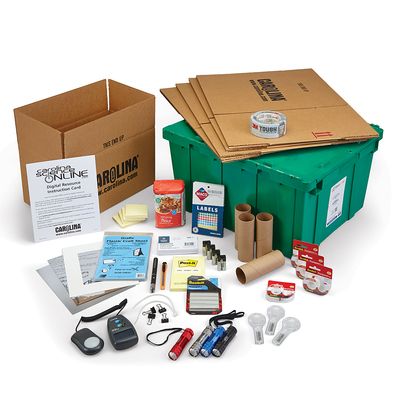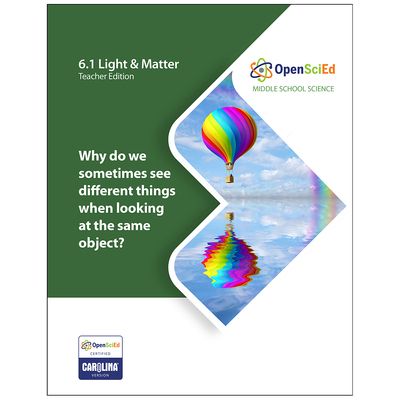Description
For additional program information and pricing, complete this form or contact your sales representative.
Grades 6–8. In Unit 6.1: Light and Matter, Carolina Certified Version*, students work to answer the Unit Driving Question: "Why do we sometimes see different things when looking at the same object?"
This unit on light and matter begins with a perplexing phenomenon of one-way mirrors and how this material can act as both a mirror and a window at the same time. Students directly observe and investigate the one-way mirror phenomenon using a scaled box model with a flashlight on one side, darkness on the other side, and a one-way mirror in between the two. Through this initial investigation, students figure out that the one-way mirror acts like a mirror on the light side of the system and a window on the dark side of the system. This experience prompts students to wonder: Why do we sometimes see different things when looking at the same object?
Through these investigations, students:
- Develop a shared set of classroom norms to guide their work together.
- Ask questions about the one-way mirror phenomenon that they investigate in the classroom by (1) manipulating light in the scaled box model, (2) measuring transmitted and reflected light off different materials, and (3) obtaining information from readings and videos.
- Agree upon and develop models to explain how light interacts with the one-way mirror, glass, regular mirrors, the eye, and the brain.
- Use a model to explain how the one-way mirror acts like a mirror on the light side of the system and acts like a window on the dark side of the system.
- Apply to an everyday phenomenon the science ideas and models developed for explaining the one-way mirror.
This 5-Class Unit Kit includes basic teacher access to instructional materials on CarolinaScienceOnline.com, plus the materials needed to teach 5 classes of 32 students per day (160 students).
Building Toward NGSS Performance Expectations
- MS-PS4-2: Develop and use a model to describe that waves are reflected, absorbed, or transmitted through various materials.
- MS-LS1-8: Gather and synthesize information that sensory receptors respond to stimuli by sending messages to the brain for immediate behavior or storage as memories.
Science and Engineering Practices
- Asking Questions and Defining Problems
- Developing and Using Models
- Constructing Explanations and Designing Solutions
Focal Disciplinary Core Ideas
- PS4.B
- LS1.D
Focal Crosscutting Concepts
- Systems and System Models
- Structure and Function
*All enhancements to materials and instruction for this Carolina Certified Version of the unit are approved by OpenSciEd to preserve the integrity of the storyline and the instructional model.
Specifications
- Shipping Information or Purchase Restrictions
-
- Contact us for program details and pricing. Call 800.334.5551.
- What’s Included:
-
- Unit Technology Pack (basic digital access to teacher's guide and all instructional resources for the teacher)
- Batteries, Alkaline, 9 V
- Binder Clips, Small
- Box Cutter
- Boxes
- Flashlights
- Flour
- Laser Pointers with Batteries
- Light Meters
- Magnifying Glasses
- Mirror Film, One-Way
- Mirrors, Plastic
- Mounting Putty
- Note Cards, Ruled
- Note Pads, Self-Adhesive, Large
- Note Pads, Self-Adhesive, Medium
- Photo Mats
- Plastic Sheets, Clear
- Sticker Dots
- Tape, Duct
- Tape, Transparent
- Tubing, Cardboard
expand to see full list - Needed But Not Included:
-
- 8 Colored Pencils
- 32 Markers, Highlighter
- 1 Markers
- 1 Meterstick
- 1 Paper, Chart
- 1 Paper, Photocopy, White
- 8 Books (3" tall)
- 32 Small Toys or Objects (must be 4" tall)
expand to see full list - Return Policy:
-
If for any reason you are not satisfied with this item, it is eligible for a return, exchange, refund, or credit up to 180 days from date of purchase. Restrictions may apply. Returns & Exchanges Policy.

